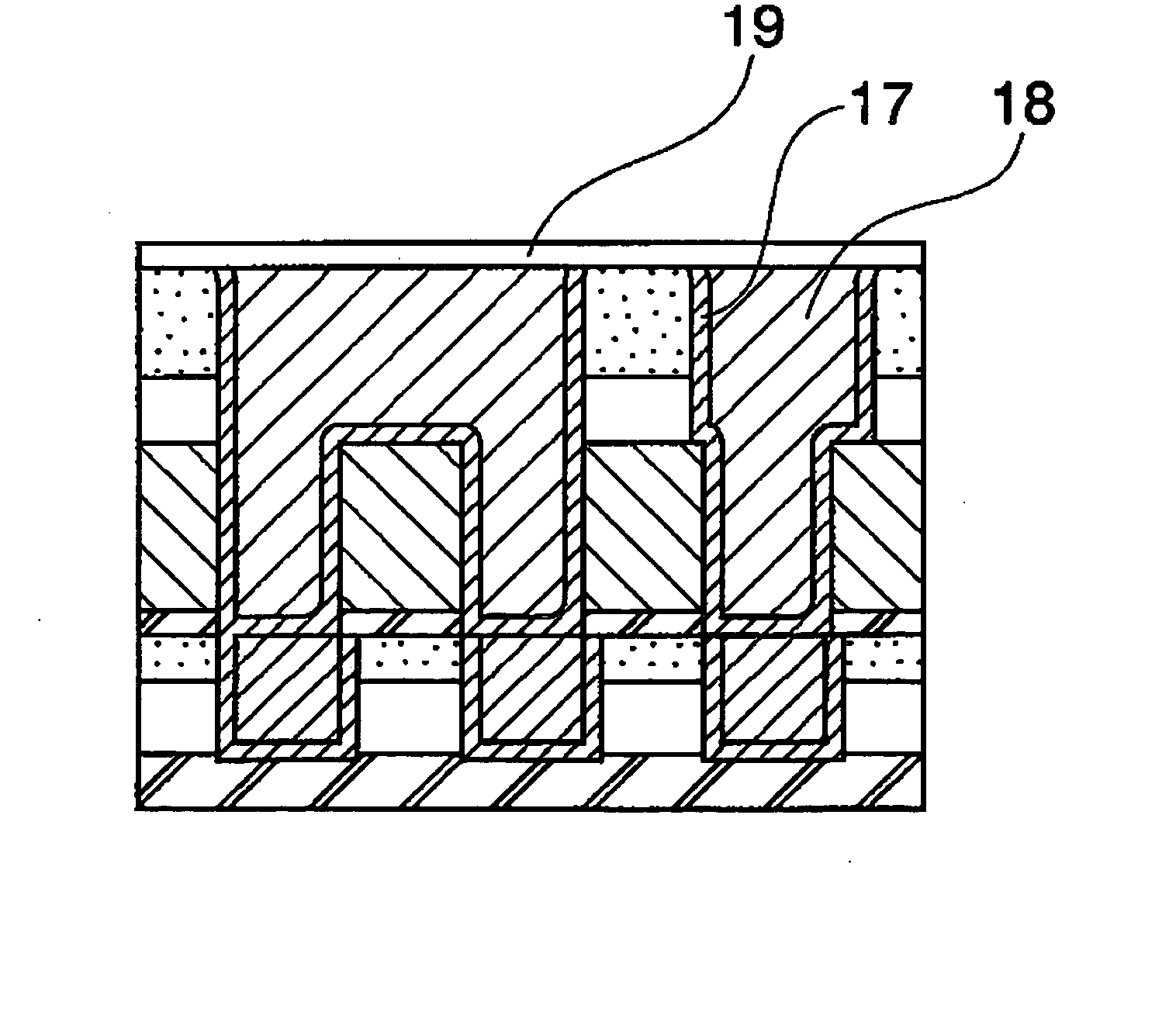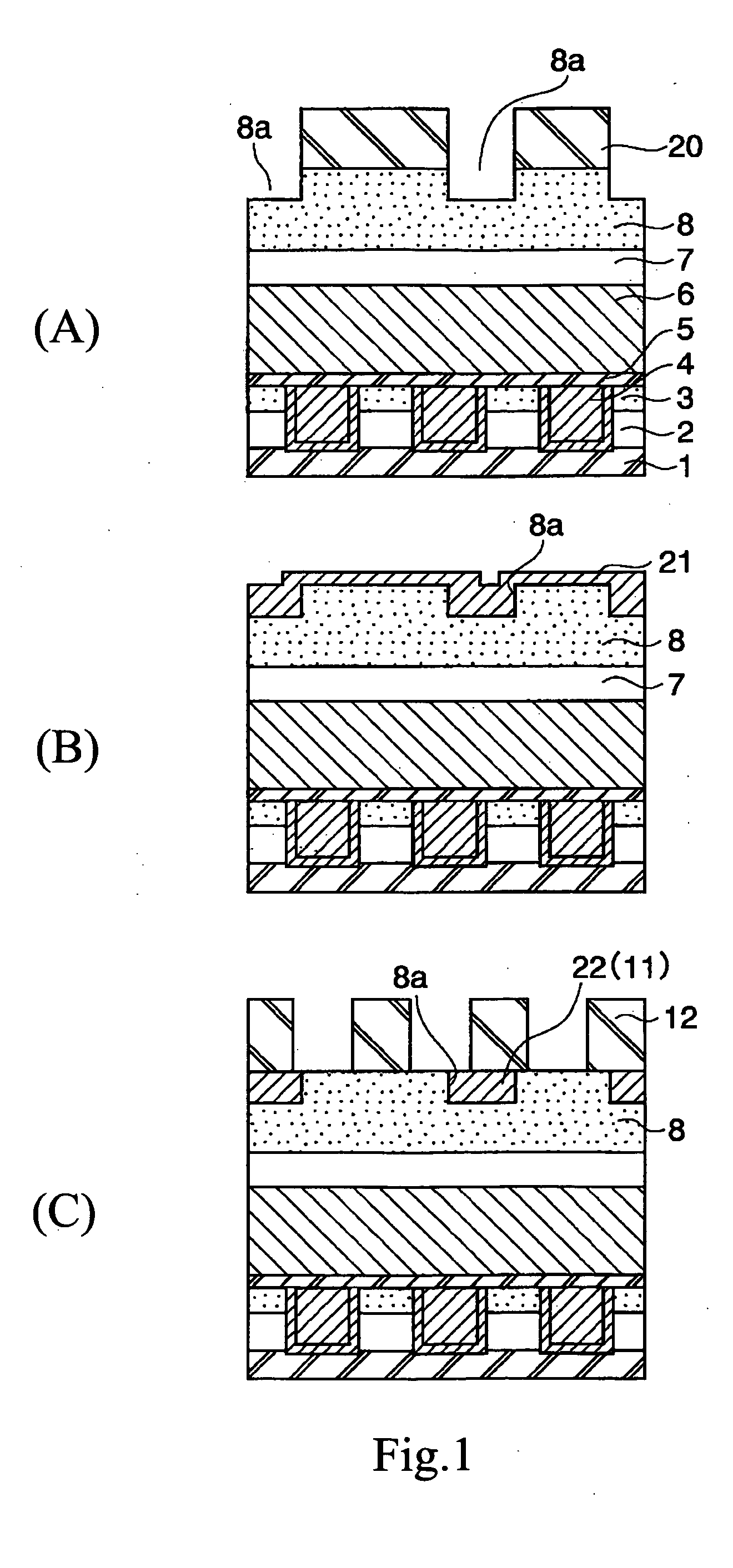Production method for semiconductor device
a production method and semiconductor technology, applied in the direction of semiconductor devices, basic electric elements, electrical equipment, etc., can solve the problem of almost opaqueness and achieve the effect of accurate pattern
- Summary
- Abstract
- Description
- Claims
- Application Information
AI Technical Summary
Benefits of technology
Problems solved by technology
Method used
Image
Examples
example 1
[0077] This example demonstrates the production method of a semiconductor device according to the first invention. FIGS. 1 to 2E are sectional views showing the sequential steps of forming the dual damascene structure according to the process in this example. For easy understanding, the same reference numerals are given to the parts in FIGS. 1 to 2E which correspond to the parts in FIGS. 5A to 5G. The same shall apply to FIGS. 3A to 4F.
[0078] In the first step shown in (A) of FIG. 1, an underlying insulating film 1 is deposited on a substrate (not shown). On this underlying insulating film 1 is formed an interlayer insulating film which is a laminate film composed of an organic film 2 and a silicon oxide (SiO2) film 3. In this interlayer insulating film is formed a buried wiring 4 of copper (Cu) film which is 250 nm thick.
[0079] Then, on the Cu wiring 4 is formed an anti-oxidizing layer which is a 50-nm thick silicon carbide (SiC) film 5. On the anti-oxidizing layer is formed an i...
example 2
[0145] This example demonstrates the process for forming the dual damascene structure which is illustrated in section in FIGS. 3A to 3H.
[0146] As in example 1, the first step shown in FIG. 3A starts-with depositing an underlying insulating film 1 on a substrate (not shown). On this underlying insulating film 1 is formed an interlayer insulating film which is a laminate film composed of an organic film 2 and a silicon oxide (SiO2) film 3. In this interlayer insulating film is formed a buried wiring 4 of copper (Cu) film.
[0147] Then, on the Cu wiring 4 is formed an anti-oxidizing layer which is a 50-nm thick silicon carbide (SiC) film 5. On the anti-oxidizing layer are formed a carbon-containing silicon oxide (SiOC) film 6 (400 nm thick) and a polyaryl ether (PAE) film 7 (200 nm thick) as an organic polymer layer having a dielectric constant of about 2.6.
[0148] Further, on the PAE film 7 is formed a first mask forming layer 8 which is a 150-nm thick SiO2 film.
[0149] In this exampl...
example 3
[0187] This example demonstrates the process for forming the dual damascene structure which is illustrated in section in FIGS. 4A to 4F.
[0188] As in example 1, the first step shown in FIG. 4A starts with depositing an underlying insulating film 1 on a substrate (not shown). On this underlying insulating film 1 is formed an interlayer insulating film which is a laminate film composed of an organic film 2 and a silicon oxide (SiO2) film 3. In this interlayer insulating film is formed a buried wiring 4 of copper (Cu) film.
[0189] Then, on the Cu wiring 4 is formed an anti-oxidizing layer which is a 50-nm thick silicon carbide (SiC) film 5. On the anti-oxidizing layer are formed a carbon-containing silicon oxide (SiOC) film 6 (400 nm thick) and a polyaryl ether (PAE) film 7 (200 nm thick) as an organic polymer layer having a dielectric constant of about 2.6.
[0190] Further, on the PAE film 7 is formed a first mask forming layer 8 which is a 150-nm thick SiO2 film.
[0191] In this exampl...
PUM
 Login to View More
Login to View More Abstract
Description
Claims
Application Information
 Login to View More
Login to View More - R&D
- Intellectual Property
- Life Sciences
- Materials
- Tech Scout
- Unparalleled Data Quality
- Higher Quality Content
- 60% Fewer Hallucinations
Browse by: Latest US Patents, China's latest patents, Technical Efficacy Thesaurus, Application Domain, Technology Topic, Popular Technical Reports.
© 2025 PatSnap. All rights reserved.Legal|Privacy policy|Modern Slavery Act Transparency Statement|Sitemap|About US| Contact US: help@patsnap.com



